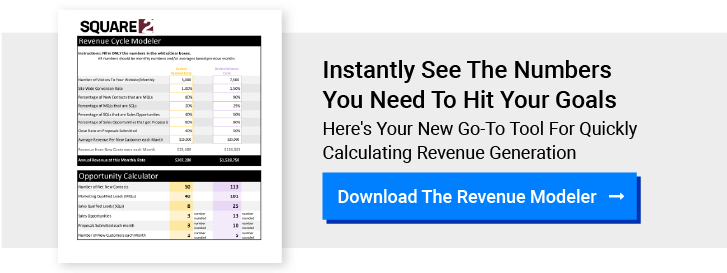
How To Find Out On Many Leads Do You Need To Hit Your Revenue Goals?
If You Want Fewer Random Acts Of Marketing, You’ll Need More Detailed Quantitative Lead Metrics
Let me know if this sounds like your company: “Well, we did $19 million in sales last year, so this year let’s shoot for $30 million. We added a few more reps and we’ve been growing steadily over the past year. We like aggressive goals here. Let’s do it.”
Everyone on the management team looks at each other generally unsure about the goal, but they agree with the goal and head back to their respective offices.
There might have been some backroom discussions on the feasibility of a goal like this. Perhaps someone looked at recurring revenue or booked revenue for the upcoming year. Maybe someone did some math on the impact this goal will have on rep sales quotas.
But I’m guessing no one did any math around the current lead flow, pipeline conversion rates, the number of new leads needed and the marketing/sales budget required to hit these aggressive goals.
The chief revenue officer (CRO) at this meeting should have said: "That goal seems like it might be doable. Let me run some numbers and see how many additional leads we’ll need, where they’ll come from and what conversion improvements we can install.
"I’ll also look at the numbers associated with our reps’ ability to turn these leads into new customers. Then I’ll give you a budget for marketing and sales that will ensure we can deliver on the revenue goals.”
If all that falls in line, you’re good to go. But if the budget isn’t doable, the lead flow just isn’t there or the sales team’s inefficiencies are exposed under this type of aggressive goal, then it’s time to rethink the goal or put the budget and plan in place to deliver the improvements and hit the new numbers.
Is this how it works at your company? This is how it should work at every company.
Here’s how to figure out how many leads you need and what your pipeline flow-through should look like to hit any level of sales performance.
Build A Revenue Cycle Model
We’ve written about this before. If you’ve talked to us, you’ve seen these models. If you’re a client, you should have one that is active and we’re working on with you.
But in short, a Revenue Cycle model is a data-driven, quantitative representation of how your marketing and sales efforts transform people who don’t know you into people who buy from you.
It starts with people early in their buyer journey or people you’ve targeted with outreach, then it tracks the conversion rate at each stage of the Cyclonic Buyer Journey™.
When this is complete, you’ll see exactly how many people visit your website, how many turn into new contacts, how many of those contacts are marketing-qualified leads (MQLs), how many of those turn into sales-qualified leads (SQLs), how many of those turn into sales opportunities, how many get proposals from your reps and then how many you close.
This full click-to-close model defines the current performance of your revenue cycle on one slide. To learn more about the Revenue Cycle, check out this blog post.
Build One That Reflects Today’s Reality
To know how many leads you need, you have to build your current state Revenue Cycle. This reflects your current level of performance all the way from click to close.
We do this often with prospects. We talk them through it and get some rough numbers from them. Then we try to validate those numbers with data from their marketing automation and CRM system. Often their stated metrics don’t align with their actual metrics.
My advice is to be honest with yourself when you build this. You might even want to underestimate if you’re making some estimates.
By the way, if you don’t have the numbers, estimating this is fine to start. Over time, you should work to get your numbers and rebuild this based on data. But in the meantime, something is better than nothing.
Having a mathematical representation of how revenue flows into your organization is game changing. Being able to see where the bottlenecks might be and knowing exactly how you’re doing at all stages of the buyer journey will transform what you work on, in what order you tackle work and how you allocate resources to start fixing areas that are underperforming.
Build One That Illustrates Your Revenue Targets
Now that you know how your Revenue Cycle is running today, you’ll want to build an aspirational Revenue Cycle.
This new model starts with the number of new clients you want to be closing on a monthly basis. If you’re currently closing 10 and you want to close 30, this is where you start.
You can use the simple model illustration shown here.

From there, you enter your information and start modeling. How many visitors do you need a month if you don’t make any upgrades across the cycle? What if you increase your close rate by 10%? What if you do a better job turning MQLs into SQLs? What if you can get more new contacts from your existing website visitors?
The answers to all of these questions are right here in these models. You’ll know exactly:
- What your site-wide conversion rate needs to be
- How many visitors you need to generate each month
- How your sales reps need to perform once the leads are passed over to sales
Finally, the question of how many leads you need to hit your revenue goals will be answered.
Here’s a Revenue Cycle model from our Butterfly Project virtual event in January. People are using this tool to make the calculations illustrated above much easier to model.
Go Deep On The Delta Between The Two (What’s Needed)
But that’s not really enough, because your next questions should be these: What do we have to do to get these new numbers? What strategies need to be installed? What tactics need to be executed? What are we doing now that we could be doing better? What technology should we be looking at?
There are still a lot of questions. However, if you know you need 20% more website visitors to drive your new numbers, then you can start working on it.
Are you getting found for the right keywords on Google? If not, work to increase your search engine optimized content. Look at your website. Is it tagged properly? Are you using the right words in your URLs? Is the site performing in a way that signals Google correctly? Do you have the right pages on your site based on your keywords?
If you need a better site-wide conversion rate, you need to look at landing pages, CTAs and CTA placement on the site. You also need to look at the content and conversion strategy across the site. Start actively looking at top landing pages and do conversion testing weekly. Start publishing more content that you can use to convert visitors into leads.
If you have back-end buyer journey challenges, start looking at sales enablement upgrades. If your reps are converting SQLs into sales opportunities at an alarmingly low rate, look at your sales process. Look at the emails your sales reps use, the content the sales reps have access to and how they’re using these assets. All of this could help uncover challenges you can address.
Create The Budget
Now that you know where and what you need to work on, make sure you have the budget and the investment from the company to execute effectively. Maybe you have the right budget and the right team, but if you identified the need for more video and you don’t have the budget or people to create video, you’ll need to make the business case to increase your budget accordingly.
The good news is you have the numbers to back it up. You can tell the CEO: “If you want these lead numbers, I need this extra budget and here’s why. Without it, I’m not sure we can get to your goals.”
If the CEO can’t free up or get the budget you need, you should have the difficult but necessary conversation about setting more reasonable goals.
But again, more good news. You can take your Revenue Cycle model to the CEO and tell her exactly how many leads you can generate with the current budget. After that conversation, you should have more budget or you should have lower goals.
 Create Shorter-Term Goals (Quarterly And Monthly)
Create Shorter-Term Goals (Quarterly And Monthly)
Once you have these numbers, your model is accurately reflecting today and you’ve agreed on the aspirational state of revenue, you’ll want to set some goals.
My advice is to set some shorter-term goals to go along with your longer-term goals. Going from 10 new customers a month to 30 new customers a month is a great goal, but that won’t happen overnight. You’ll need mid-journey milestone goals to make sure you’re on track.
Long-distance runners are familiar with a tactic where you pick visual milestones along the way and work toward passing those. This keeps your mind off the many miles still ahead of you.
The same will work with your marketing. Instead of obsessing about the goal of 30 new customers a month, work to get from 10 this month to 14 next month. Next go from 14 to 20, then from 20 to 26 and finally from 26 to 30. Once you get to 30 new customers, you can set new goals and new interim milestones.
The same exercise would be in play for any related goals, including conversion rate, website visitors, conversion rate for MQLs to SQLs and close rate. Set interim goals, track your progress and work toward your final goals.
Now You Have A Strategy And An Action Plan
I do a lot of public speaking, and I almost always ask the attendees to stand up and only sit down if they’ve hit their revenue goals for the past month, the past quarter, the past two quarters and the past four quarters.
Do you know that roughly 90% of the audience has to sit down at every single session? This means only 10% of companies are hitting their sales goals month over month and quarter over quarter.
HubSpot research reports this number at 23%, while Salesforce reports that 46% of companies are hitting their sales goals regularly.
In my opinion, it is an epidemic of poor sales results. Almost everyone blames sales and marketing. CMOs and VPs of Sales have the shortest tenures in the executive suite. But it’s not their fault. Well, maybe it is for not speaking up.
However, if your company is picking sales goals based on arbitrary numbers or simply increase everyone’s numbers by 20% and calling it a day, it’s not going to work.
For some of you, this might seem basic. But you would be surprised at how many companies have no context for their goals. They have no relationship between investment and the size of their goals. There is no connection to the tasks that need to be executed to reach their goals.
With this approach, you’ve connected all the quantitative goals with your overall business goals. You’ve aligned the investment expectations and you’ve set some interim goals.
Most importantly, you’ve aligned the tactics you plan to execute with the gaps in your current Revenue Cycle. You’ve put resources where the gaps are greatest and prioritized the areas you want to attack.
If you’ve done all of this work, you’re in the top 10%, no question about it. Make these changes and a whole host of opportunities are going to open up to you, including the ability to not only reach your goal of 30 new customers a month but to scale that to 50, 80 and 200 over time.

CEO and Chief Revenue Scientist
Mike Lieberman, CEO and Chief Revenue Scientist
Eliminate Hit-or-Miss Marketing Moves
Get advice, tips, tools and guidance to generate more leads for your company in this weekly email newsletter.



Eliminate Hit-or-Miss Marketing Moves
Get advice, tips, tools and guidance to generate more leads for your company in this weekly email newsletter.














